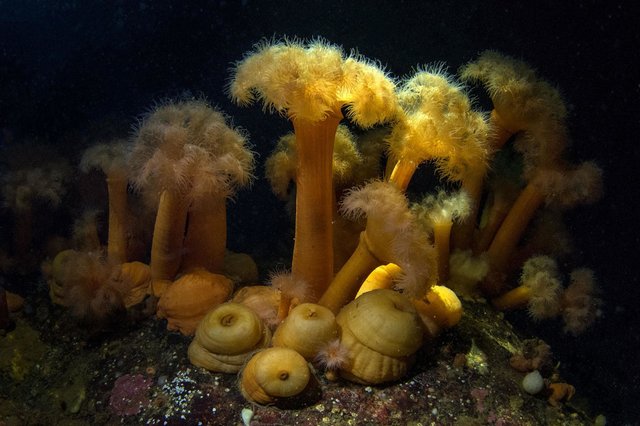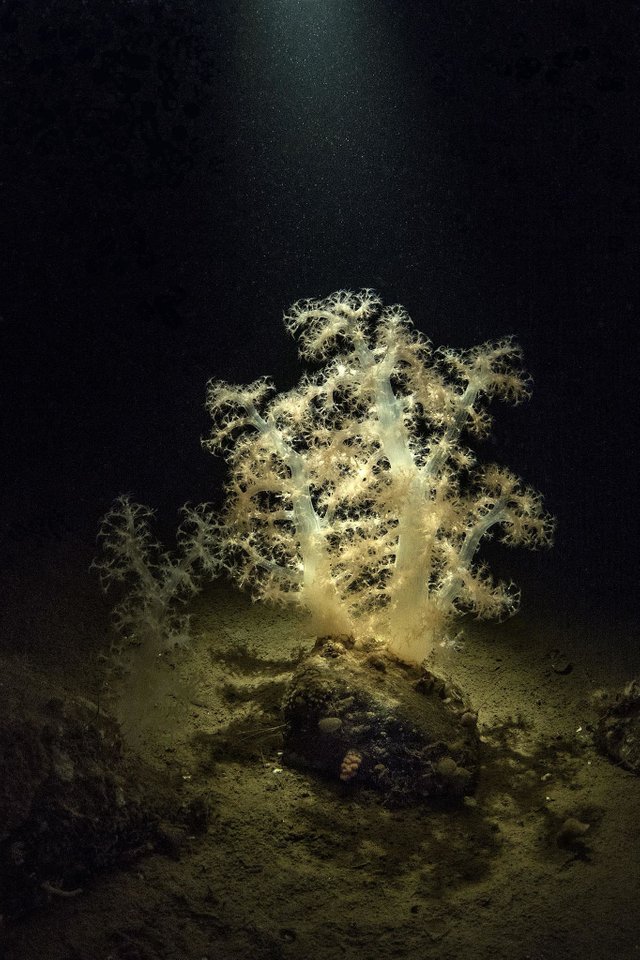The wonderful creatures that live under the Arctic ice
Photographer Viktor Lyagushkin says the waters of the White Sea are actually green due to the abundance of phytoplankton. For 28 days in April, Lyagushkin spent three hours a day under this ice in northwestern Russia, photographing its incredible marine life, which includes marine angels, hoods, soft corals and sea anemones.
For Lyagushkin, the spectacular scenes he witnessed under the ice were supernatural and he compares entering water through a hole in the ice with Alice's descent down the rabbit hole into Wonderland.

The sea anemone Metridium senile is a predator and traps small organisms that float in the current.
PHOTO BY VIKTOR LYAGUSHKIN
He acknowledges that to dive under the ice it is necessary to pay special attention to safety, but there are times when he is totally absorbed in the beauty around him. "It makes me very happy to photograph marine angels," he says. Fascinated as one of them danced in front of his camera, he says the experience is like seeing a real angel.
In another dive, he witnessed a beautiful underwater snowfall as snow fell through the hole in the ice and was unable to melt in the salty, icy water.
Discovering soft corals lying twisted on the seabed was equally captivating, though not as inspiring. He asked Mikhail Safonov, founder and executive director of the Arctic Circle PADI Dive Centre and Lodge, what happened to them. Safonov, a doctor of biology, assumed that the animal might have been disturbed by a diver's fin, or perhaps it was "in a bad mood," he joked.
Working in this extreme ecosystem poses many technical challenges. Spending hours at sub-zero temperatures is physically exhausting and also hard on diving equipment. While working on this project, 11 oxygen supply tubes exploded. Lyagushkin prefers to work with one or two assistants, and since they cannot speak underwater, they have invented specific hand signals to communicate and know where to place and reposition lighting equipment.
To capture the smallest invertebrates in the White Sea, Lyagushkin uses continuous light and strobe to show the animals in their aqueous environment, which is obscured by the ice that covers it.
Although Lyagushkin has photographed many underwater landscapes, this is the first time he has used fisheye macro lenses, which have allowed him to take detailed photographs of tiny sea creatures as well as their habitat.
In an image Lyagushkin titled "Cosmic Brain" appears a Mnemiopsistenophore floating near the ice. Thetenophores do not bite, but are voracious carnivores that feed on zooplankton, eggs and larval forms of various fish and invertebrates, and even othertenophores.

The soft corals inhabit the deep waters of the White Sea and display colors such as white, yellow, pink and orange.
PHOTO BY VIKTOR LYAGUSHKIN
It is one of Lyagushkin's favorite images. According to him, it looks like a creature whose illustration could appear in Herbert Wells' science fiction novels. Although small, measuring between seven and 10 centimeters, Lyagushkin imagines the ctenophore as "a gigantic, majestic alien brain living in a green world.
With his work, Lyagushkin aims to show "the tiniest creatures that live with us in this enormous world. His work highlights the way these animals live together in the White Sea, the only epicontinental sea that freezes every year.
He says that, in general, we know very little about abundant marine life. And because of global warming, the animals of the northern seas perish before we can learn more about them.
In the 15 years he's been visiting the White Sea, Lyagushkin explains that the ice diving season has shortened and the ice sheet has thinned. A recent September, he traveled there to photograph jellyfish, but all had died due to an abnormally warm summer.
The dangers of climate change are imminent and "it would be insulting to species in the Arctic Ocean if we didn't find time to study and photograph them," says Lyagushkin.
Sources; https://www.nationalgeographic.com/
https://es.gizmodo.com/estas-no-son-criaturas-de-ciencia-ficcion-es-la-fauna-1790408078
https://www.xlsemanal.com/conocer/naturaleza/20170721/la-espectaculares-criaturas-artico.html
Great post!
Thanks for tasting the eden!